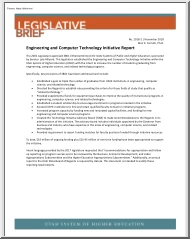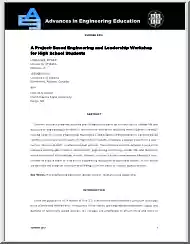Datasheet
Year, pagecount:2010, 5 page(s)
Language:English
Downloads:8
Uploaded:March 28, 2013
Size:122 KB
Institution:
-
Comments:
Attachment:-
Download in PDF:Please log in!
Comments
No comments yet. You can be the first!What did others read after this?
Content extract
Business Intelligence Strategies, Keys to success: Demand Management With business intelligence strategies getting so much attention, why then is there a problem with delivering on the promise of business intelligence projects ? Most such “strategies” developed are really more tactical than anything and are very prescriptive. Typically when companies embark on such “strategic” exercises there’s usually a very central event that’s driving this as in: • Change in Leadership • Enterprise cost reduction initiatives • M & A activity • Implementation of a new ERP system The above list is not exhaustive and was not intended to be either. But in any case the driving event usually ends up being the central theme in any subsequent strategy that’s developed. The environment in which businesses operate is so dynamic that any strategy driven by any one perspective does not stand the test of time as business and the challenges it faces vary over time. Even when
organizations have the best of intentions and have all the executive support they need and commit the necessary resources to these endeavors they end up with misalignments with projects and overall business strategies. So, if anything the central theme of any strategic framework has to be flexibility. A strategic framework guided by core principles as opposed to a tactical response to a situation or an event is what is called for. What then are those core principles to craft your systems around? As business strategies are formed, operations and IT teams need to be able to execute to the best of their abilities. So a systematic approach would require ways to deliver on business capabilities desired, the technology and processes that need to be adapted for execution, the products or services that needs to be delivered (in our case, information) and last not but the least ways to maintain strategic alignment. Some fundamental dimensions to develop capabilities around are: Demand
Management & Delivery teams Technological Fit Information centricity Strategic Alignment In this first of a four part article I will focus on the Demand Management and Delivery teams. Delivery teams and Demand Management How do you staff your BI teams? What kinds of skill sets do you hire and develop in-house ? What kind of skill sets do you augment ? When you first develop a BI organization typically the instinct is to look at standard organizational charts for BI teams and staff accordingly. If BI and Information Management are looked at from a service oriented perspective, four areas emerge that could serve majority of the business needs of any organization. The four services are: Ad-Hoc Service: supporting day-to-day information needs of the business whether its operational or strategic in nature. Standard Report Service: Producing, maintaining, and enhancing canned reports for management and various functions within the company. This would
include not only deploying standard reports but continuously validating information produced and supporting queries from business users. BI Infrastructure development: Developing enterprise datawarehouse, operational data stores, application data marts. This team would be driven by business requirements but would continuously focus on developing the right architectures. Decision Support Services OR Advanced Analytics Services: Most advanced analyses that would require piecing together information from multiple reports or those analyses that do not lend themselves well to the traditional BI slice-dice but is more algorithmic in nature. Once you have this operating model how do you manage demand ? Most BI managers in any industry will tell you how the appetite for information has grown exponential over the years. BI teams are perennially in the business of developing reports. There’s hardly any time to do anything else So from your initial mission of empowering the
users you eventually just end up with technologies that let you program faster . When BI teams aren’t able to scale according to business needs the impulse is to think of an IT fix. Once again what we have at play here is the classic supply side vs. demand side fix There are things that can be done on the “supply side” which are: Improve productivity Better Project Management Adopt best practices Implement better technologies Improve processes Hire more people All of the above while necessary do not necessarily tame demand. The “Demand side” can be tamed by: Develop self-service capabilities Train the end-users to think analyses more than reports Meet periodically with business leads to anticipate demand better Institute a governance council to prioritize projects, tasks for BI teams and the priorities are all business priorities Increase transparency on the supply side to show capacity So with a more
comprehensive look at both supply and demand one can aspire to manage delivery better. The next question is staffing the BI operating model. The cornerstone of any BI/DW implementation is a strong data foundation. This comprises of data models(logical/physical), an enterprise datawarehouse, metadata management, business requirements management. So core skills to hire/develop/retain are Architecture, Data Modeling, BI Requirements Management and last but not the least Datawarehousing Project Management. The implementation requires certain key additional skillsets like ETL development & Reports development. This is an area where once the high level and detailed architectures are developed it can be handed down to DW/BI programmers who can execute. Nevertheless most companies hire/procure talent in this second tier. This is easier to hire since it is more of a toolset based skill. Not to trivialize the nuances of any tools, but to do most simple/medium complexity tasks in any tool,
ETL or Reporting is not too hard to pick up. Given that ETL development and reports development form the bulk of the implementation most companies focus on hiring for these activities. In a changing business environment priorities get shifted, business units get consolidated, projects get shelved. How then are you supposed to rationalize and retain talent based on varying demand. Even in a scenario where the business is thriving and there’s more and more demand for BI a more rational approach would be organize and plan for staff at two tiers. One of which is fixed and is core to the organization The other i.e variable is hired on demand to support initiatives This tier can be trimmed if project priorities change or if projects get shelved. Major investments are made in tier1 to upgrade and retain talent. Since tier1 sets the strategy and architecture this is where more seasoned resources would be required. These resources could move between projects lending architecture & design,
project management and stakeholders management services. It is also important to maintain good vendor relations and select a couple of strategic partners who understand your company, company’s strategy and are able to provide skilled resources in a timely fashion. Fig1. Two-tier talent management for DW/BI teams The highlighted area above represents staff augmentation. This is where you can bring in external resources with specific tool/technology skills, have them work off of detailed specifications and instructions. The Tier-1 represents your internal staff where significant investments are made to develop industry, company knowledge as well as capabilities in core areas like architecture and modeling. This is the most important dimension in our strategic framework. As I mentioned before even to execute on a strategy a service oriented organization model combined with a flexible staffing plan is the cornerstone to maintaining flexibility in the face of change. In the next part
I will discuss technology fit and how flexibility can drive your technology decisions and eventually support your business strategy
organizations have the best of intentions and have all the executive support they need and commit the necessary resources to these endeavors they end up with misalignments with projects and overall business strategies. So, if anything the central theme of any strategic framework has to be flexibility. A strategic framework guided by core principles as opposed to a tactical response to a situation or an event is what is called for. What then are those core principles to craft your systems around? As business strategies are formed, operations and IT teams need to be able to execute to the best of their abilities. So a systematic approach would require ways to deliver on business capabilities desired, the technology and processes that need to be adapted for execution, the products or services that needs to be delivered (in our case, information) and last not but the least ways to maintain strategic alignment. Some fundamental dimensions to develop capabilities around are: Demand
Management & Delivery teams Technological Fit Information centricity Strategic Alignment In this first of a four part article I will focus on the Demand Management and Delivery teams. Delivery teams and Demand Management How do you staff your BI teams? What kinds of skill sets do you hire and develop in-house ? What kind of skill sets do you augment ? When you first develop a BI organization typically the instinct is to look at standard organizational charts for BI teams and staff accordingly. If BI and Information Management are looked at from a service oriented perspective, four areas emerge that could serve majority of the business needs of any organization. The four services are: Ad-Hoc Service: supporting day-to-day information needs of the business whether its operational or strategic in nature. Standard Report Service: Producing, maintaining, and enhancing canned reports for management and various functions within the company. This would
include not only deploying standard reports but continuously validating information produced and supporting queries from business users. BI Infrastructure development: Developing enterprise datawarehouse, operational data stores, application data marts. This team would be driven by business requirements but would continuously focus on developing the right architectures. Decision Support Services OR Advanced Analytics Services: Most advanced analyses that would require piecing together information from multiple reports or those analyses that do not lend themselves well to the traditional BI slice-dice but is more algorithmic in nature. Once you have this operating model how do you manage demand ? Most BI managers in any industry will tell you how the appetite for information has grown exponential over the years. BI teams are perennially in the business of developing reports. There’s hardly any time to do anything else So from your initial mission of empowering the
users you eventually just end up with technologies that let you program faster . When BI teams aren’t able to scale according to business needs the impulse is to think of an IT fix. Once again what we have at play here is the classic supply side vs. demand side fix There are things that can be done on the “supply side” which are: Improve productivity Better Project Management Adopt best practices Implement better technologies Improve processes Hire more people All of the above while necessary do not necessarily tame demand. The “Demand side” can be tamed by: Develop self-service capabilities Train the end-users to think analyses more than reports Meet periodically with business leads to anticipate demand better Institute a governance council to prioritize projects, tasks for BI teams and the priorities are all business priorities Increase transparency on the supply side to show capacity So with a more
comprehensive look at both supply and demand one can aspire to manage delivery better. The next question is staffing the BI operating model. The cornerstone of any BI/DW implementation is a strong data foundation. This comprises of data models(logical/physical), an enterprise datawarehouse, metadata management, business requirements management. So core skills to hire/develop/retain are Architecture, Data Modeling, BI Requirements Management and last but not the least Datawarehousing Project Management. The implementation requires certain key additional skillsets like ETL development & Reports development. This is an area where once the high level and detailed architectures are developed it can be handed down to DW/BI programmers who can execute. Nevertheless most companies hire/procure talent in this second tier. This is easier to hire since it is more of a toolset based skill. Not to trivialize the nuances of any tools, but to do most simple/medium complexity tasks in any tool,
ETL or Reporting is not too hard to pick up. Given that ETL development and reports development form the bulk of the implementation most companies focus on hiring for these activities. In a changing business environment priorities get shifted, business units get consolidated, projects get shelved. How then are you supposed to rationalize and retain talent based on varying demand. Even in a scenario where the business is thriving and there’s more and more demand for BI a more rational approach would be organize and plan for staff at two tiers. One of which is fixed and is core to the organization The other i.e variable is hired on demand to support initiatives This tier can be trimmed if project priorities change or if projects get shelved. Major investments are made in tier1 to upgrade and retain talent. Since tier1 sets the strategy and architecture this is where more seasoned resources would be required. These resources could move between projects lending architecture & design,
project management and stakeholders management services. It is also important to maintain good vendor relations and select a couple of strategic partners who understand your company, company’s strategy and are able to provide skilled resources in a timely fashion. Fig1. Two-tier talent management for DW/BI teams The highlighted area above represents staff augmentation. This is where you can bring in external resources with specific tool/technology skills, have them work off of detailed specifications and instructions. The Tier-1 represents your internal staff where significant investments are made to develop industry, company knowledge as well as capabilities in core areas like architecture and modeling. This is the most important dimension in our strategic framework. As I mentioned before even to execute on a strategy a service oriented organization model combined with a flexible staffing plan is the cornerstone to maintaining flexibility in the face of change. In the next part
I will discuss technology fit and how flexibility can drive your technology decisions and eventually support your business strategy





 When reading, most of us just let a story wash over us, getting lost in the world of the book rather than paying attention to the individual elements of the plot or writing. However, in English class, our teachers ask us to look at the mechanics of the writing.
When reading, most of us just let a story wash over us, getting lost in the world of the book rather than paying attention to the individual elements of the plot or writing. However, in English class, our teachers ask us to look at the mechanics of the writing.